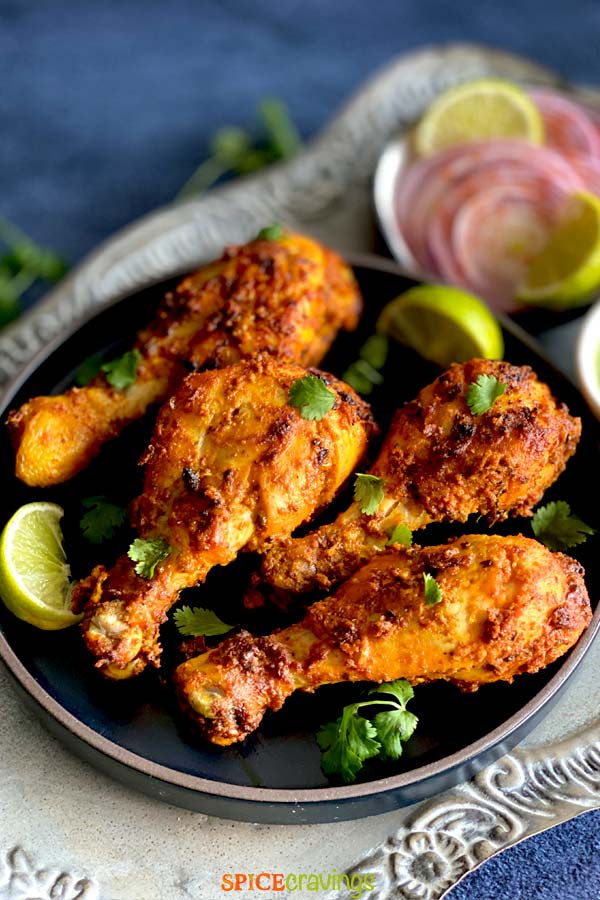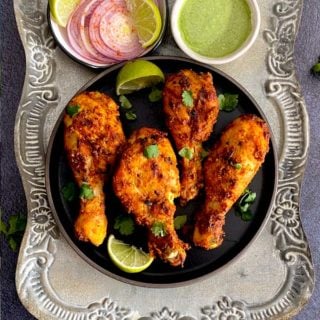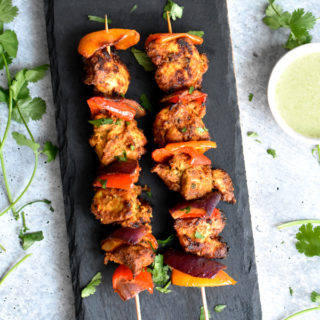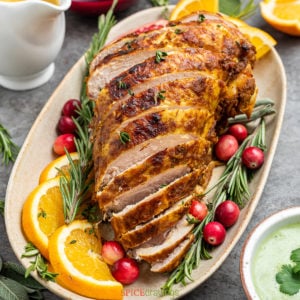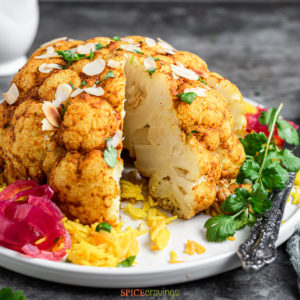Learn about ways to achieve a similar texture and taste using modern home appliances such as the air fryer or oven. Tandoori cooking has been around for centuries. It is a style of cooking that creates exceptionally flavorful meat thanks to the char-broiled finish from hot coals and fire.
While most of us may not have a tandoor oven in our backyard, there are many tricks to the trade that allow you to reach the same crisp, smoky exterior and moist, succulent interior. Keep reading to learn all about tandoori, with many recipes to get you inspired!
What is Tandoori
Tandoori (pronounced Ton-Do-Ree) is a style of cooking that places skewers of marinated meat, paneer, or vegetables into a deep and incredibly hot clay oven. This, in turn, creates pockets of deep char and smoky flavor on the accompanying protein.
What Does Tandoori Taste Like
Tandoori cooking is like the Indian spiced version of BBQ. The meat is charred on the outside, with notes of smoke and fire, while the mix of spices creates earthy, aromatic undertones. You might also like: 10 Easy & Authentic Tandoori Recipes
What is a Tandoori Oven
A Tandoori Oven is a cylindrical clay oven with ceramic sides. It is typically heated with charcoal, but more modern versions use gas or electricity. Traditionally, a tandoor oven is built into the ground or an enclosure, which allows the heat to reflect off the sides and only escape from the top. This allows the meat to be fully immersed in the direct heat of the fire (which can reach upwards of 500 degrees F), giving way to that sought-after, char-broiled flavor.
What Makes Tandoori Red
Tandoori meals are bright red or yellow. The red comes from ground red chilies, while the yellow comes from turmeric, or in some cases, saffron. Many Indian restaurants use red food coloring or dye as a less expensive alternative to creating that iconic color. To achieve a similar color at home, I use a combination of Kashmiri red chili powder, paprika, and turmeric.
Components of Tandoori Cooking
Tandoori dishes are made with a variety of marinated meat. The following are the main components of a tandoori recipe: Meat: While chicken is undoubtedly the most popular, other meats can include lamb, beef, goat, mutton, or fish. Vegetarian Alternatives: Paneer, vegetables, or tofu, cut into large 1-2 inch size pieces, all make wonderful vegetarian options. Yogurt: Yogurt helps the herbs and spices to cling to the meat. Additionally, the natural enzymes (active microbes and lactic acid) break down the meat’s muscle fibers to make it juicy and tender. Spices: Tandoori spice is made with a mix of roasted and ground spices. These include some combination of cumin, coriander, Kashmiri red chili powder, paprika, cayenne pepper, turmeric, and garam masala. Aromatics: Ginger and garlic add notes of spicy, savory flavor.
How to Make Tandoori Dishes At Home
While many of us do not have a tandoor oven at home. But, there are ways to achieve a similar texture and taste using the following modern home appliances:
Air Fryer
The beauty of an air fryer is that it can reach super hot temperatures while using a light cooking method - air! This is how we get the sought-after crispy yet light texture with very little fat or oil.
Oven
Most modern ovens can reach temperatures upwards of 500 degrees F, which mimics the extremely hot environment of a tandoor oven. Check out the list of Popular Tandoori Recipes below, many of which can be made in the Air Fryer and Oven!
Popular Tandoori Recipes
If you are wondering what is tandoori chicken, I have got you covered with plenty of tandoori recipes, and fun variations. The following are my most popular tandoori recipes on the blog:
Pro Tips for Tandoori Cooking
Make deep slits: To really get the marinade in and around the meat, make a few ½-inch deep gashes into the fleshy part of the meat before coating it with the marinade.Marinate: Marinating is required to get the most flavor infused into vegetables or meat. For optimal flavor, marinate the following for the time listed: Paneer: 30 minutes, Tofu / Veggies / Fish: 30 minutes - 1 hour, Chicken: 2-4 hours, Lamb / Beef: 4-6 hours. Chicken, beef, and lamb can also be marinated overnight, but for no more than 12 hours.Yogurt: Use plain, full-fat Greek yogurt for its thick texture, which will cling to the meat well and hold the spices intact.Ginger and garlic: Use fresh ginger and garlic in the marinade as opposed to ground ginger or garlic powder.Check your spices: Spices release oil over time and lose flavor. Use ground spices within 3 months and whole spices within 6 months - 1 year. Store in a cool, dark place away from heat or light to preserve the essential oils.Acid: Fresh lime and lemon juice will always be more bright and crisp than the bottle alternatives. Use fresh citrus fruits for the best flavor.Fresh herbs: A garnish of fresh herbs like cilantro and mint take tandoori to new heights. Keep cilantro and mint on hand and store in the fridge.


